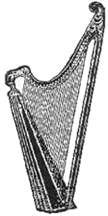|
             
Copyright
Helen Forder
2004
|
|
The
Harp, by Brinley Richards ...
continued
|
page 6
|
|
In 1640 a Scotch harp from
Argyleshire was brought, by a lady of the family of Lamont, to the House of
Lude, upon her marriage with Robertson of Lude, where it has ever since
remained. Gunn (History of the Harp) says:- "It had been for several centuries the harp of a
succession of Highland bards. It is thirty-eight inches in height, and
sixteen inches broad. The strings, thirty in number, are fixed as in the
present day, in the middle of the sounding-board. The workmanship is very
good, and remarkable for its great strength. Another instrument, known as
Queen Mary's Harp, was presented by Her Majesty to Miss Beatrix Gardyn of
Banchorry during a hunting excursion in Perthshire. It has been kept in
such excellent preservation, that one ignorant of its history would be apt
to pronounce its age not to exceed seventy or eighty years".
|

|
|
Queen Mary, however, though
a highly accomplished musician, did not play the harp; her favourite
instrument being the lute, at that time popular both in France and England.
The history of Ireland affords undoubted proofs that the harp from a remote
period was the favourite instrument, and that it continued in use until the
end of the eighteenth century. In consequence of the rapid decrease of
performers on the Irish harp, a Society was established for the purpose of
reviving it. A meeting was accordingly held at Belfast, July 1792, when no
more than ten harpers could be brought together. Mr. Bunting, who was
appointed to note down the airs played on the occasion, has given an
interesting account of it. Among the harpers was Hempson, a venerable old
man, who attracted much curiosity, as he actually played the "wire
strings" with his long finger-nails, a custom peculiar to the
ancient Scotch and Irish. Another of the party was a Welshman, Williams,
the description of whose performance is of singular interest as
illustrating the marked difference in the character of the two national
instruments; "the bold and martial
tones of the Cambrian harp, contrasting with the sweet and more expressive
sounds of the Irish harp"
(Bunting's Hist.). Other meetings were also held in 1809 - 1813;
but it was then too late, and
|
|
"The harp that once through Tara's Halls
The soul of music shed,"
|
|
had become a thing of the
past, or merely a poetical idea.
|
|
back 1 2 3 4 5 6 7 8 next
|
|
